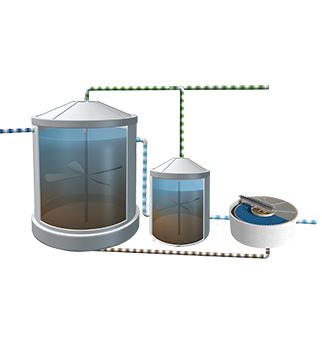The history of anaerobic digestion (AD) is lengthy and can be traced back to as early as 10th-Century BCE in Assyria when biogas was used to heat bathwater. Then, in the 17th-Century it was first determined that decaying organic matter could result in flammable gasses. Today we know capturing this methane, a potent greenhouse gas, is important in the fight against climate change. So what’s next in this continuing evolution?
Anaerobic flocculent biomass technologies are well recognized for their high efficiency in treating industrial wastewaters with high total suspended solids and fats, oils and grease (FOG).
Sparthane™ is the latest anaerobic solution, designed to treat industrial effluents with a wide range of concentrations, at maximum removal efficiency. It is part of Biothane’s Biobulk portfolio and features a unique method of operation that is designed for having a high tolerance to concentrated FOG and/or high levels of total suspended solids (TSS).
It is currently used by customers in the food and beverage, chemical and pharmaceutical industries to treat wastewater with wide range total chemical oxygen demand (TCOD) (seven to 50 grams per liter) and high TSS (up to 20 grams per liter) and/or high FOG (up to four grams per liter).
AD technology, with its ancient roots, is constantly being improved as it may hold the key to helping the world better meet its energy needs versus energy consumption. The team at Biothane — a subsidiary of Veolia Water Technologies — is a leading brand in the field of anaerobic industrial wastewater treatment, and they’re on a mission to give us a more environmentally friendly way of dealing with industrial wastewater by turning sludge into a resource.

Christian Kuijlaars, Global Sales Manager, explains more about Sparthane™ Advanced, the soon-to-be-released, patented and compact solution featuring a single tank that is suitable for diluting wastewater with chemical oxygen demand (COD) 3 to 20 grams per liter.

What are the unique selling points of Sparthane Advanced?
Sparthane is designed to treat industrial effluents and Sparthane Advanced will be able to treat the majority of streams with a high particulate COD directly without pre-treatment. This will exclude power and chemical consumption as well as difficult to operate pre-treatment steps such as dissolved air flotation. The system will be capable of achieving high loading rates and subsequently relatively small tanks with wastewater that previously could only be treated in large volumes.
What excites you the most about this technology?
“It unleashes the maximum potential of the biomass through the approach of a feast-famine regime. This allows the biomass to really work its hardest for the client as it maximizes the potential of the process effluents into biogas. This also means more natural gas to add to our energy mix which will help us reduce our reliance on fossil fuels.”
For customers looking to invest in an AD solution, what are the biogas generator advantages Sparthane Advanced offers?
“Sparthane Advanced will enable the client to treat the majority of its streams and to convert the maximum — more than 90 percent — of its potential into burnable biogas. On top of that Sparthane Advanced removes the necessity to pre-treat the effluents meaning a significant reduction in any post-treatment processes. This results in considerable savings in terms of both power and carbon footprint.”
It’s estimated that biogas can reduce global emissions by 18 to 20 percent. What role does Sparthane Advanced play in this?
“This advanced technology is able to convert the majority of the COD in the process effluent into methane, and this methane can be used in boilers, thereby offsetting the intake of liquefied natural gas. Furthermore, COD is also converted into a vaporizable stream, whereas, previously, it would have been treated in an aerobic treatment to reach an equal removal level — which requires additional power and therefore additional emissions."



